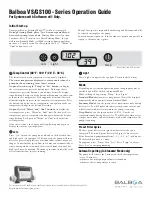
Page 26
5B-11. Testing the Safety Shutoff
(for standing pilot)
After lighting the heater, test the ignition system
safety shutoff.
1.
With the main burners firing, turn the gas valve
control knob off.
2.
Turn power to the heater off.
3.
Set the temperature control to its lowest setting.
4.
Wait 5 minutes.
Caution
Flame Hazard. Failure to wait 5 minutes, or not
turning the gas valve knob to OFF, may cause the
flow of unlighted main burner gas.
5.
Turn the gas valve control knob to the PILOT
position.
6.
Without pressing the control knob down, it
should be impossible to light the pilot.
7.
Relight the pilot following the lighting
instructions found on the inside of the heater.
8.
Reset the temperature control.
9.
Light the heater following the instructions found
on the inside of the heater.
5B-12. Testing the Safety Shutoff
(for automatic pilot)
1.
Find the red silicone rubber insulated wire that
runs from the pilot to the ignition stud on the
ignition control module.
2.
With the main burners firing, use an insulated
pair of pliers to disconnect the sensor wire from
the control module. Do not pull on the wire. The
main burner flame should immediately go out.
3.
Turn the gas valve control knob to the off
position.
4.
Reattach the red silicone wire to the control
module.
5B-13. Testing the Igniter Electrode
To test the igniter electrode:
1.
Make sure all of the wire connections on the
ignition control and the gas valve are tight.
2.
Make sure the wiring agrees with the wiring
diagrams found on the inside of the heater.
3.
Check for sparking at the igniter electrode.
4.
If there is sparking at the igniter electrode, but
there is no pilot ignition after 2 or 3 minutes, clip
a lead from the voltmeter between the yellow
wire terminal on the transformer and the brown
wire terminal on the gas valve.
5.
If the voltmeter does not show voltage, replace
the ignition control.
6.
If the voltmeter reads 20 to 28VAC, but there is
no pilot ignition, check for
a: air in gas lines.
b: restrictions in gas line, valve or pilot tubing.
c: clogged pilot orifice.
If these are correct then replace gas valve (see
Section 4C).
WARNING
Never attempt to repair the gas valve. Such
attempts will void the warranty, and could lead to
dangerous results.
5B-14. Testing the Pilot Thermocouple
(for standing pilot)
If there is voltage to the gas valve, the pilot is lit,
the thermocouple is properly positioned, the
temperature control is set high enough to call for heat;
then the gas valve or the pilot thermocouple may be
the problem. To test the pilot thermocouple:
1.
Remove the pilot thermocouple fitting from the
gas valve.
2.
Clip one lead of a millivolt meter on the center
post of the tube and the other lead on the copper
pilot thermocouple shield.
3.
If the millivolt meter reads about 30 millivolts,
go to step 5.
4.
If the millivolt meter does not show voltage or
voltage is very low, it could indicate a dirty or
clogged pilot. Clean and recheck the pilot
thermocouple. If voltage still does not show or is
very low, replace the pilot thermocouple.
5.
To test the pilot thermocouple under load, screw
the pilot thermocouple into the end of a millivolt
reading adapter (see Figure 40).
6.
Clip one lead of a millivolt meter to either side of
the millivolt adapter and clip the other lead to
ground.
7.
Light the pilot following the instructions found
on the inside of the heater.
8.
Set the temperature control high enough to call
for heat.
9.
With the heater firing, take a millivolt reading.
10.
If the millivolt meter does not read about 15
millivolts, replace the pilot thermocouple.
5B-15. Testing for Pilot Burner
(for spark ignition)
When the pilot burner lights, the sparking should
stop and the main burners should fire. If the sparking
continues and the main burners do not fire:
1.
Check all wire connections, ignition cable, and
using a mirror, make sure there is a pilot flame.





































